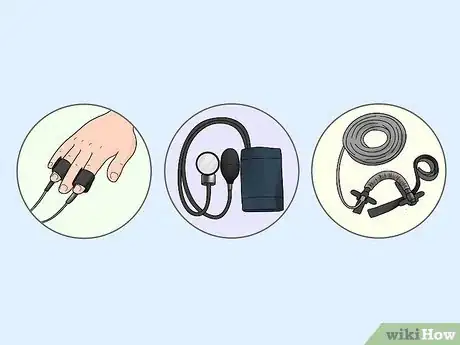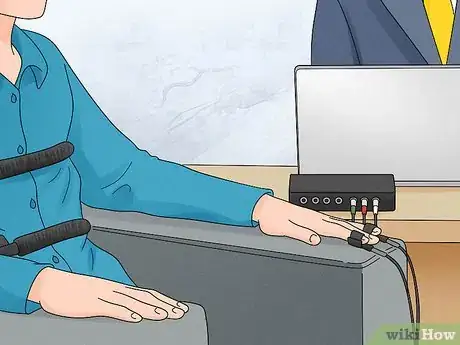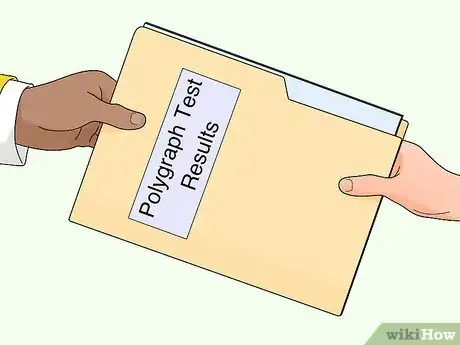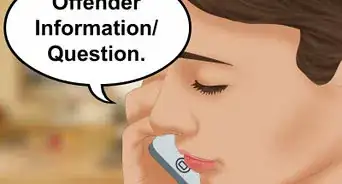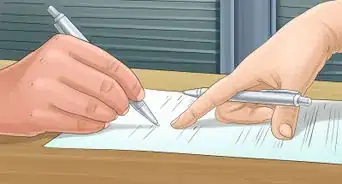This article was co-authored by Clinton M. Sandvick, JD, PhD. Clinton M. Sandvick worked as a civil litigator in California for over 7 years. He received his JD from the University of Wisconsin-Madison in 1998 and his PhD in American History from the University of Oregon in 2013.
There are 16 references cited in this article, which can be found at the bottom of the page.
wikiHow marks an article as reader-approved once it receives enough positive feedback. In this case, 100% of readers who voted found the article helpful, earning it our reader-approved status.
This article has been viewed 323,079 times.
A polygraph test is a test that uses a machine to measure responses from your body during the course of an interview, usually consisting of questions about your past.[1] Passing a polygraph test, also known as a “lie detector” test, is often a requirement during pre-employment screening for a career in law enforcement.[2] The test simultaneously measures several physiological responses, such as changes in breathing, pulse, and sweating, and records these measurements on graph paper. The graph shows what periods of physiological response coincided with the moment in time when a particular question was asked. Increased physiological response and high stress while answering a particular question, according to the theory behind the test, suggests that the examinee is lying.[3] Faith in the reliability of the polygraph test, however, varies.[4] [5]
Steps
Understanding the Test
-
1Understand the various parts of the polygraph equipment. This will help you appreciate what the machine is and is not capable of. When you sit down to take the exam, you will be fitted with a blood pressure cuff, a pneumograph, and two galvanometers.[6]
- A galvanometer is a finger plate that is placed on your fingers and that measures how much you perspire as a result of stress.[7]
- A blood pressure cuff keeps track of your blood pressure. The blood pressure cuff will be similar to one that you may have experience with from visiting your doctor. When the exam starts, it will fill up with air and create a tight grip around your arm, and when the exam ends, the examiner will loosen the cuff.The blood pressure cuff measures the number of beats or pulses per minute that your blood produces as it goes through your arm. As you get more nervous, the blood pressure cuff will communicate greater beats per minute to the polygraph machine.[8]
- A pneumograph is a set of tubes that is placed over your chest and that measures how much air you are breathing.[9]
-
2Know that the machine cannot read your mind. This may be something the examiner wants you to believe, but believing so will increase the chances that you will do poorly on the exam. Despite commonly being referred to as a "lie detector" test, a polygraph exam cannot actually prove beyond a doubt that you are lying. Rather, it detects physiological activities that often occur when someone lies, because of the stress that lying is thought to produce. More specifically, the machine detects:
- Changes in your breathing.
- Sweat gland activity.
- Cardiovascular activity through a blood-pressure cuff or similar device.
- In some cases, motion (e.g. nervous fidgeting) through motion sensors.
Advertisement -
3Understand why the test is used. The polygraph is not 100% accurate. Supporters of the test argue that it is about 90% accurate, while critics suggest that that figure is an overestimation of the machine's capability.[10] Note that because the machine is widely accepted to be fallible, it is not typically used in criminal court proceedings.[11] In fact, most states agree that the results are not admissible in court.[12] Some reasons the test is used as part of pre-employment screening are:
- Polygraphs promote truth-telling. Because polygraph tests are often intimidating, they encourage the examinee to reveal any facts that could otherwise lead to failing the test.[13]
- Polygraph tests deter undesirable applicants. People who might be hiding something important that might make them an untrustworthy police officer will be less likely to apply for the job because they know they will be subjected to a polygraph.
- The polygraph examination is a fast and efficient way to gather background information.
Preparing for the Test
-
1Sleep and eat normally before the exam. Get a restful sleep the night before the exam. Being well rested and relaxed will help you to be calm and consistent during the exam, increasing your odds of passing. Do not skip breakfast the morning of the exam or otherwise deviate from your normal eating pattern. Sticking to your routine will help your body function normally and reduce the risk of error on the test.[14]
-
2Avoid taking medication to calm you down. You may believe that taking anti-anxiety medication before the exam is a good idea, but those with years of experience with the polygraph suggest that doing so is not a good idea.[15] That is because anti-anxiety medications can affect your heart rate and breathing, thereby producing inaccurate results.[16] The examiner will likely ask you if you have taken any medication or alcohol beforehand. If you are feeling ill and need to take medication (e.g. cold medication), then consider rescheduling your test.
-
3Treat the test like a job interview. Do most of the things you would do for a job interview. This means you should dress conservatively and appropriately. Wear a suit if you have one; if not, still try to dress as formally as possible, for example by wearing a dress shirt and trousers. Show up with ample time to spare before the test (at least 30 minutes before the exam).[17]
- Turn your phone off before walking into the test.[18]
- Wear an undershirt to absorb sweat, as you can expect to perspire during the test.[19]
- Expect to be nervous and know that it is perfectly normal to feel nervous before the test.[20] Try your best, however, to relax as much as possible before and during the test.
Taking the Test
-
1Take the pretest interview. Typically, you will be asked to take a 20 to 30 minute interview, focusing on the areas you will be asked about during the polygraph exam. You may also be asked to fill out a form providing background information prior to the polygraph test.[21]
- These questions will focus on your previous employment, driving record, drug use, and criminal history.
- The examiner will explain the process of the polygraph test to you in such a way as to emphasize the reliability and precision of the test. The goal here is to place truthful subjects at ease, while heightening the anxiety of any subject with something to hide.
- Be honest and complete on this pretest. Failure to do so will only give you reason to lie during the polygraph. If these lies are detected, this will create suspicion on the part of those making hiring decisions in the department, and the truth may not as bad as your potential employer might imagine it to be if your answer shows up on the test as untruthful.[22]
- For example, if you tried marijuana a few times in college, it is better to admit this during the pretest than to answer "no" to the question "have you ever used illegal drugs" during the actual polygraph and have it detected as untrue. This could suggest to the examiner that you are hiding a much more severe drug problem.[23]
-
2Remain calm as the machine is connected. For many people, being hooked up to the polygraph machine is the part of this process that produces the most anxiety. Keep your cool as the sensors are attached to your body. Here is what you can expect:
- Corrugated rubber tubes or electronic sensors will be attached to your abdominal area.
- Two small metal plates or electrodes will be attached to your fingers.
- A blood-pressure cuff will be placed around your arm.
- All of these sensors will be attached to the polygraph machine, which will probably be connected to a laptop that shows the results.[24]
-
3Take the test. After a series of "control" questions, you'll be given the actual exam. Again, keep your cool and be truthful.
- The control questions are intended to establish baselines for how you respond to questions that you are answering truthfully versus those which may provoke anxiety because you are answering dishonestly.
- For example, you will probably be asked some very simple questions that no one would have any reason to lie about, followed by some questions that you are directed to answer untruthfully. The examiner will note how your body responds to each.
- Questions during the exam will focus on the same topics as the pretest: criminal activity, previous employment, drug use etc. You should also expect to be asked at the end of the process if you have deliberately lied on any question.
- The examiner may try to provoke you to say something that conflicts with your pretest, possibly by trying to appear sympathetic or friendly. Whatever you do, do not reveal anything damaging to the examiner that was not revealed in the pretest. Inconsistencies will raise red flags.
- If you've answered the pretest questions honestly and comprehensively, you should have nothing to be anxious about during the actual exam.
-
4Wait for your results. Once you've completed your test, all you can do is wait for your results. A couple of things to keep in mind as you wait:
- Law enforcement agencies don't expect you to have had a perfect life. A minor infraction, like having smoked a small amount of marijuana as a young person, is unlikely to disqualify you, so long as you've been forthright about it.
- Most polygraph exams come back with one or two "blips" that suggest untruthful answers. Because of this, applicants are often given the benefit of the doubt. It is understood at most police departments that the polygraph is a flawed test, and you will not usually be disqualified for one or two answers that registered as untrue.
Warnings
- Be truthful in all law enforcement job applications. Even if a lie is not uncovered by the polygraph test, you may still lose your job if it is uncovered later.[25]⧼thumbs_response⧽
References
- ↑ Anthony Lehman, Liar Liar, You Are Hired (2014) Chapter 1.
- ↑ Harold Charles, How to Pass a Polygraph (2012) Introduction.
- ↑ http://www.nolo.com/legal-encyclopedia/lie-detector-tests-tell-truth-29637.html
- ↑ James Q. Murdoch, How to Pass a Polygraph (2014) Chapter 1.
- ↑ http://www.nolo.com/legal-encyclopedia/lie-detector-tests-tell-truth-29637.html
- ↑ James Q. Murdoch, How to Pass a Polygraph (2014) Chapter 4.
- ↑ James Q. Murdoch, How to Pass a Polygraph (2014) Chapter 4.
- ↑ James Q. Murdoch, How to Pass a Polygraph (2014) Chapter 7.
- ↑ James Q. Murdoch, How to Pass a Polygraph (2014) Chapter 4.
- ↑ http://abcnews.go.com/US/story?id=92847
- ↑ http://www.apa.org/research/action/polygraph.aspx
- ↑ http://www.legalmatch.com/law-library/article/admissability-of-polygraph-tests-in-court.html
- ↑ http://lawenforcementjock.com/police-polygraph-questions/
- ↑ http://lawenforcementjock.com/police-polygraph-questions/
- ↑ Harold Charles, How to Pass a Polygraph: Pre-Employment Screening Techniques (2012) Chapter 5.
- ↑ http://www.cnn.com/TRANSCRIPTS/1101/12/ng.01.html
- ↑ Harold Charles, How to Pass a Polygraph: Pre-Employment Screening Techniques (2012) Chapter 5.
- ↑ Anthony J Lehman, Liar Liar, You Are Hired (2014) Chapter 2.
- ↑ Anthony J Lehman, Liar Liar, You Are Hired (2014) Chapter 2.
- ↑ Anthony J Lehman, Liar Liar, You Are Hired (2014) Chapter 2.
- ↑ http://www.uta.edu/police/Pre%20Polygraph%20Questionaire.pdf
- ↑ http://lawenforcementjock.com/police-polygraph-questions/
- ↑ http://lawenforcementjock.com/police-polygraph-questions/
- ↑ http://lawenforcementjock.com/wp-content/uploads/2014/03/poygraph-info-graphic.jpg
- ↑ http://www.nytimes.com/1997/11/14/nyregion/an-officer-s-dream-is-shattered-by-a-lie.html
About This Article
A police polygraph test can be nerve-wracking, but you can deal with it by keeping relaxed beforehand and staying cool during the test. Get a good night’s sleep before the test so you’re well rested, which will help you stay alert throughout. You should also follow your normal routine, including eating breakfast, to keep your energy levels up. Avoid taking anti-anxiety medication, since it can negatively affect the results. You should aim to arrive well ahead of time for the test so you don’t have to rush. After you answer some pretest questions, you’ll be connected to the polygraph machine, with censors on your abdomen, fingers, and wrist. If you start feeling nervous, take deep breaths to stay calm. Answer all questions truthfully and calmly. Remember that it’s perfectly normal for your results to show 1 or 2 incorrect answers, since the machine sometimes makes errors. To learn more, including how the polygraph equipment works, keep reading!
